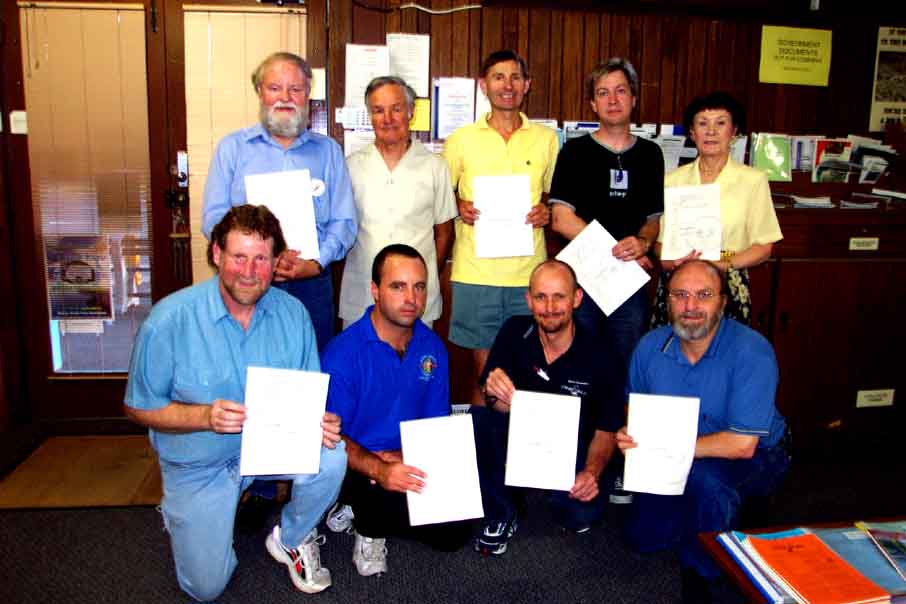
MLSSA
Newsletter
MARCH 2003
No. 297
"Understanding, enjoying & caring for our oceans"
Next Meeting
This will be held at the Conservation Centre, 120 Wakefield Street, Adelaide on Wednesday 19th March commencing at 7.30pm with our speaker who will be Ben Kear from the SA Museum. He will speak on his work at the SA Museum which includes projects concerning marine fossils.
Contents
MV Falie Easter 2002 Part 1
After The Encounter Part 3
Great Southern Dive Expo
Visit To Victor Harbor
Farewell To Mingyon
Nature Conservation Council’s Efforts To Save The Grey Nurse Shark
Jewels of the Sea (JOTS) Kits Report
A Footbridge Too Far: Not Quite Belly-Up In The Stream
News Release - Hon John Hill
Contributors
This month our authors are Chris Hall, Steve Reynolds, Philip Hall and David Muirhead. There is a press release from the Hon John Hill as the final item.
The article "A Footbridge Too Far: Not Quite Belly-Up In The Stream" will be continued next month with the first part of a followup article on the medical aspects of the story.
Recipients of Volunteer Certificates
Rear L to R: Philip Hall, Scoresby Shepherd (Patron & Certificate Presenter), Steve Reynolds, Danny Gibbins, Margaret Hall
Front L to R: Chris Hall, Geoff Prince, David Muirhead, Phill McPeake
Easter 2002
Part 1
by
Chris HallThe Falie is the last operating trading ketch in South Australia and is an historic tall ship.
She was built in Holland in 1919 and is approximately 50 metres long and 302 tonnes gross. In 1923 she sailed to Port Adelaide taking 103 days and maintaining a 59-year career on Australian waters of which most of that time was spent sailing South Australian waters.
During that time her cargo included wheat, barley, oats, timber and other supplies trading mainly between the ports on Yorke and Eyre Peninsulas as well as interstate to Hobart and Melbourne.
During World War II, Falie was commissioned by the Royal Australian Navy to act as a ‘watch dog’ in Sydney Harbour, then as a cargo vessel in New Guinea waters.
She returned to southern waters and remained in commercial service until 1982 when she retired as the last ketch sailing in South Australia.
Falie was restored for commercial use and the Government of South Australia commissioned her to operate as a non-profit enterprise to fund community activities, which helps maintain the ship.
Under this current arrangement she operates as a vessel for day and twilight cruises, diving and fishing trips, school voyages and eco tours.
On day trips she carries 66 passengers and can accommodate 20 people for longer trips with a professional crew of 7-9 to look after all your needs and run the ship.
Easter Thursday and a bright warm evening at Port Adelaide. The MV Falie was tied up at Number 10 Berth in the Port River awaiting the arrival of 20 divers. At approx. 6pm the first of the divers arrived which began a hive of activity of loading personal gear while trying to find their allocated bunk. Having sorted out our personal gear we assisted the crew with loading all the dive gear which was quite considerable, two tanks per diver, regs, BCDs, wetsuits, drysuits, fins, masks, etc, and for some the all important cray (lobster) catcher. After all this activity most of the divers and crew adjourned to the pub for a meal and a couple drinks. Having sated our thirst and appetite it was back to the ship for the start of our four-day diving sojourn.
The skipper took the helm, the first mate barked a few orders and the crew made way for our departure. The trip up the Port River was uneventful and most people (divers and crew) got to know one another over a few drinks and nibbles on deck while watching the sun set. Once out of the port and into the open sea, about a one to two-metre swell, most of the divers busied themselves with sorting out their gear and headed to bed as the next few days would be quite hectic.
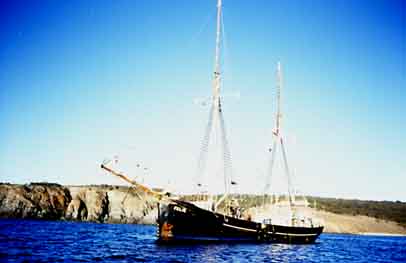
Falie
near Cape Torrens,
Kangaroo Island
Dawn broke with a few of the divers feeling a little seasick and the attendance to breakfast was testimony to that. It was dull, overcast and a bit disappointing as we were expecting a bright and sunny day but unfortunately you can't order the weather to your liking especially at Easter.
After breakfast most of us congregated on deck to watch the coast pass by and see Wedge Island, so called because from a distance it looks like a huge wedge, appear slowly on the horizon. For those that were feeling well enough fresh baked hot cross buns were served on deck for morning tea.
As we drew closer to Wedge Island we had a very pleasant interlude as a pod of common dolphins frolicked in our bow wave. Being a sailing ship and for those a little more daring, hanging off the bowsprit provided a great vantage point to observe the dolphins. They kept us amused for quite some time and provided some psychological relief for those who were feeling a bit queasy.
Finally we arrived at North Island late in the morning and the decision was made to have our first dive here, as the wind was too strong and in the wrong direction for diving Wedge. We were divided into two groups of ten, six divers in the aluminium boat and four in the inflatable. I was in the first group and assigned to the aluminium boat, which was launched first. Although it was a bit difficult getting into the boat in a heaving sea the crew were marvellous at getting us in and out of the boats especially with all the heavy diving gear. After finding us a suitable entry site the crew assisted us in getting kitted up and into the water.
The dive was good but not spectacular. The vis was 6-8 metres and my depth varied from 6-18 metres. There was quite a bit of surge, which is not too good for photography, but the marine life was good. The highlights of this dive were the large western blue gropers, New Zealand fur seals and a leafy seadragon. The leafy sea dragon along with the weedy sea dragon is only found in southern Australian waters. Even though it wasn’t the best of dives it was enjoyable and I managed to take a roll of film. Back to the Falie and lunch while the second group had their dive.
A decision was then taken by the skipper to up anchor and head for Wedge Island, only a kilometre or so away. The inflatable was hauled on board and the aluminium was used for looking for a suitable anchorage/dive site. This took about an hour but it was well worth the wait, as this remained our anchorage for the next 30 hours or so.
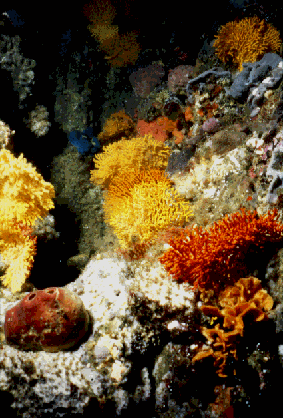
Gorgonians in a small cave
Firmly at anchor and in the lee of Wedge Island due to the prevailing winds, which unfortunately kept us from the best dive sites, the inflatable was launched. Our group kitted up for the next dive and into the boats. We had about a kilometre of low cliff to choose our dive sites from and luckily we picked right straight off. All along this coast there was a multitude great dives so it didn’t really matter where you were dropped off. We were dropped of in about 15-20 metres so we headed towards the island. The terrain was rocky, but away from the island it became sandy with seagrass beds so heading towards the island was the best option. Again the sealife was abundant, seaweeds, seagrasses, ascidians, molluscs, seastars, crustaceans and a myriad of fish species. Unfortunately it was getting late in the day and the ambient light was poor so it affected the autofocusing on my new camera. However I did get a few good photos but mainly of invertebrates. The diving at Wedge is similar to the temperate West Coast of Ireland. The invertebrates and algae are almost the same and certainly the terrain is familiar but the fish life is so different. At times you'd think it was the tropics with the colour and variety of fish, sometimes 30-40 different species. Juvenile fish in particular can be very colourful, like the barber perch and scalyfin. Adult cowfish, leatherjackets and harlequin fish also have great colour and all make the dive very enjoyable. Anyway after observing and photographing for about 50 mins it was time to make my assent and back to the Falie.
After getting changed and cleaning the camera it was back on deck to partake of a few beers, wine or soft drinks, all-inclusive in the cost, as the mood took you. It was help yourself and with the keg right next to where I had my gear stowed I was able to wash the salt out of me while washing salt out of my gear. Just as I finished out came the nibbles so what more could you need, a great sea view, food, drink and good company.
Most of us just hung around the deck swapping stories and tales of what we had seen on our two dives while others busied themselves with a multitude of different tasks.
Before we knew it the dinner bell had rung and we all hurried down to the dinning room to sate our hunger brought on by the diving and a couple of pre-dinner drinks. Waiting for us was a three-course meal superbly cooked and served by the crew. Accompanying the meal was plenty of good South Australian wine. All the meals were excellent with ample portions so nobody went hungry. If you did feel hungry or thirsty there was tea/coffee and biscuits available anytime, just help yourself.
After dinner most of us headed back up on deck for a few quiet drinks and chat. One of the divers was entertaining a group of divers with some magic tricks. I still don’t know how he managed to get that piece of rope back into one piece after cutting it several times.
Once the on deck entertainment finished most people returned to their cabins to get a good night sleep. The gentle sway of the ship at anchor lulled its passengers into the land of nod and snores were heard all round the ship. This was a decided improvement on the thump, thump, thump of the diesel engine from the night before.
Part 3
By Steve Reynolds
I witnessed the arrival of the Enterprize and the One and All in front of a crowd of about 1,000 people. The local Mayor later unveiled a commemorative plaque at the lighthouse close to the jetty where the reserve is now known as Investigator Park after Flinders’ ship. Later that day I sighted the two tall ships in Spencer Gulf sailing on towards Port Victoria for the next leg of proceedings.
Port Victoria held a costume ball, village fair, theatre restaurant, art exhibition, promenade concert and sailing regatta from 15th to 17th March. The Costume Ball was held on Friday 15th March for 44 Cape Horners and nine descendants of Matthew Flinders.
Many other affiliated events were held at locations on Yorke Peninsula about this time. There were family fun days, "Life Be In It" barbecues, music festivals, farming shows, food and wine celebrations, competitions and live music. Towns such as Balgowan, Minlaton, Point Turton, Warooka, Wool Bay, Port Julia and Marion Bay all got involved in the spirit of the occasion. People lined up along the coast to see the tall ships sail by.
The Enterprize and the One and All sailed from Port Victoria to Kangaroo Island. They arrived at American River on Kangaroo Island on Thursday 21st March. Events here consisted of a community event titled "Island Encounter – Astronomy" which focused on celestial navigation, a triathlon, rowing, sailing, plant collection and drawing.
The two tall ships then sailed to Kingscote for the weekend. An "Island Encounter - Food and Wine Fair", rock eisteddfod, petanque competition and a sailing regatta were held there on Saturday 23rd March. There was a re-dedication of the 100 year old Flinders’ monument, a launch of the "Public Art Project Sail Sculpture" completed by children from all over the island, formation flying by the RAAF Roulettes and much more.
On Friday 22nd March Keith Conlon opened an exhibition by John Ford marking the meeting of Flinders and Baudin. John’s exhibition "Chart the Art of Discovery" was held in The Gallery, Port Community Art Centre at Port Adelaide. It ran from 23rd March to 23rd April and I managed to see this exhibition on two occasions.
Another Encounter 2002 event was "The Botanical Legacy of 1802" held at the State Herbarium from 22nd to 28th March. Botanic historian David Mabberley gave lectures on 21st and 22nd March. "The Botanic Legacy . . ." was a self-guided tour to learn about the plants collected during the Encounter voyages.
On March 22nd there was a fire burning close to the Bluff. There was no cause for alarm, however, and it wasn’t some kind of signal. The French Government had sponsored a visit to Australia by Karom Thomasson, the French artist and sculptor. Thomasson specialises in giant crop sculptures and he produced one near the bluff. It was a 6ha artistic figure that he called "Cosmosapiens" which he translates to mean "child of the third millenium". Evelyn Roth, a Canadian artist, lit the burn-off that helped to create the figure on the ground. The Inman Valley CFS were on standby and they doused the fire with water.
A symposium titled "The Encounter 1802 – Art of the Flinders and Baudin Voyages" was held at the Art Gallery of SA on 23rd March. This day was the 200th anniversary of Flinders first setting foot on Kangaroo Island.
A community event was held at Mount Lofty on 23rd March. This included the unveiling of a plaque to commemorate the sighting of Mount Lofty by Flinders exactly 200 years earlier. I dare say that the two tall ships at Kingscote tried their best to see what was going on at Mount Lofty.
Events were then held at Edithburgh the next day (24th March) with the two tall ships One and All and Enterprize in attendance. About 3,000 people were there for events such as food and craft stalls, entertainment, (progressive?) dinner, food fair, breakfast on the jetty and a fireworks spectacular. Restored Narungga graves, previously unmarked at Edithburgh cemetery, were dedicated. The "Dedication of the Graves" was done during a service held at the cemetery.
On the same day Anthony Brown opened an exhibition in the Greenhill Gallery at North Adelaide. It was called "Investigators: French and British Mariners and Artists in the South Seas 1770 to 1850", an exhibition of maps, charts and prints from four great voyages of discovery between 1770 and 1850. It focused on Flinders and Baudin (1802), but also included James Cook (1770) and Dumont d’Urville (1837). The exhibition ran until 16th April.
It was then on to Ardrossan for the One and All and Enterprize for more events on Wednesday 27th March. About 2,000 people gathered to witness the end of the "Tall Ships Chart Relay". SA’s Governor, Marjorie Jackson-Nelson, opened the Cheetham Salt/District Council of Yorke Peninsula Art Exhibition. At a closing ceremony for the Chart Relay, charts were presented to Council officials and all the participants received a replica chart. All kinds of awards and prizes were to be awarded to members of the public. Events continued through the weekend with a craft fair, street entertainment, a jetty party and fireworks.
There was an official reception at Government House on Thursday 28th March for descendants of Flinders and Baudin. The exhibition "Matthew Flinders: The Ultimate Voyage" opened at the SA Maritime Museum on Friday 29th March. It ran until 23rd June and I managed to see it at some stage. It was a touring exhibition from Sydney’s Mitchell Library. A statue of Flinders stands outside the Mitchell Library in Sydney, New South Wales. Another statue of him stands in North Terrace, Adelaide.
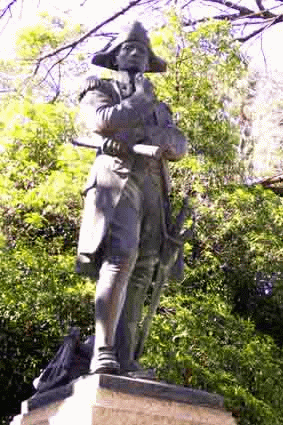
Here is the statue of Matthew Flinders that stands on North Terrace, Adelaide.
An art exhibition was held at Penneshaw on Kangaroo Island from 29th March to 4th April. The "Penneshaw Easter Art Exhibition" was held in the Penneshaw Hall with categories including the encounter and the150 year old Cape Willoughby light station.
A re-enactment of Flinders’ landing as well as a "Flinders Focus (or Festival)" was held at Port Wakefield on Saturday 30th March. Four people went ashore from a rowboat and collected plant specimens. They then rowed into Port Wakefield and raised the British flag, as a re-enactment of Flinders’ landing, in front of about 1,500 people. An exhibition was held in the old courthouse there.
The tall ships, however, had moved on to Port Adelaide for the weekend. All four tall ships gathered at the main wharf in Port Adelaide, along with the French Navy frigate Vendemiaire, for a wharf-side festival. The Vendemiaire was visiting Adelaide from Noumea for the celebrations on behalf of the French Government. All five ships were open to the public.
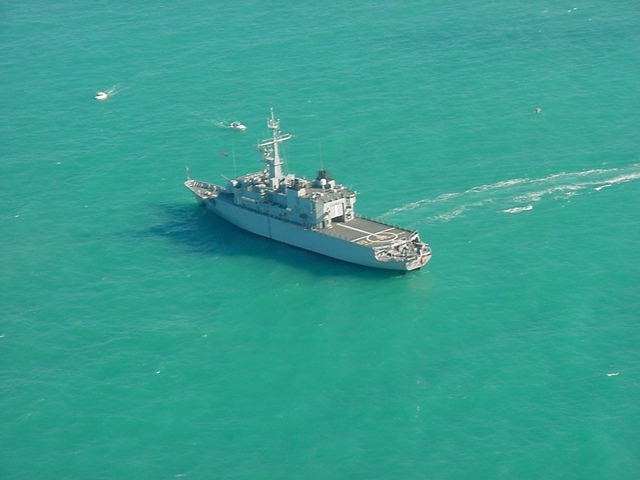
The French Navy frigate Vendemiaire at anchor.
Great Southern Dive Expo
Our Society was an exhibitor at the Great Southern Dive Expo at Wirrina Cove Resort recently. We were able to promote our Society and also sell copies of our 2003 calendar and the JOTS and OG books. Steve manned our display on the Saturday with the help of Shamila James who had offered her assistance. James Brook and David Turner (Squid) were both there for the Reef Watch stand. Chris Ball was there for the Australian Marine Conservation Centre. David Sanderson was there next door to us promoting his dive shop at Aldinga and Paul Lunn and Michael Wescombe-Downe were there on the other side of us selling shark shields. Bob Ramsay had a display of hard-hat diving helmets. Bill Jeffrey was there for the Dept of Heritage. Daisy was there for Glenelg Scuba. Greg Perry, who organised the whole show, promoted his own Dolphin Dive. Then there were winery, clothing and accommodation stands and other dive shops such as Underwater Sports Diving Centre. David Turner and Bill Jeffrey were two of the speakers for the day.
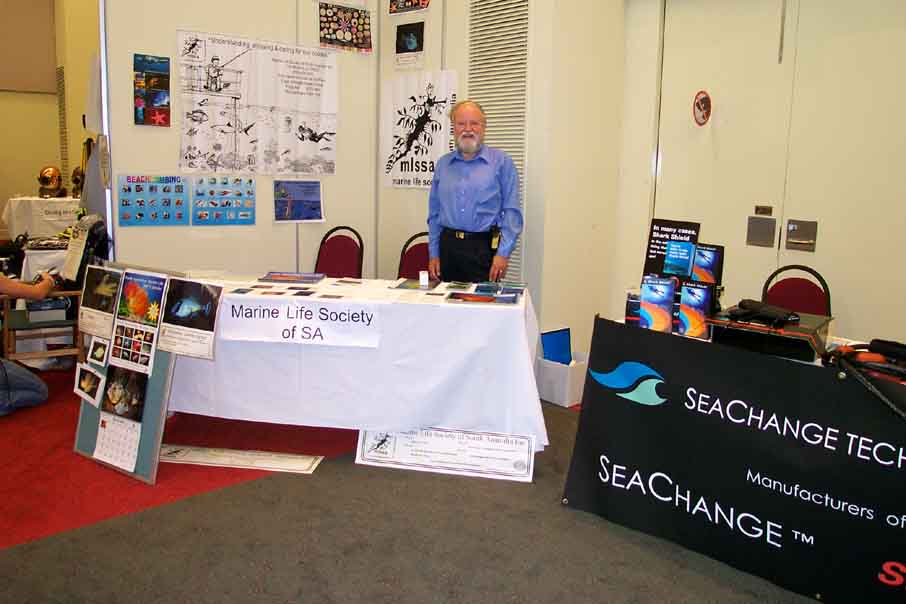
Philip and our stand on the Sunday
Philip and Margaret Hall tended our stand on the Sunday and David Muirhead was one of the speakers for the day. David (surprise, surprise) won a prize for his photograph of the four Old Wives in a line, which was published in our 2002 calendar. This picture is to go on display in the Yankalilla Tourism office. Phill and Barbara McPeake arrived during the Sunday afternoon and Phill spent much time meeting up with old friends. Philip negotiated with Michelle from Yankalilla Tourism for the display some of our publicity pictures and leaflets.
Several Calendars and Jots books were sold to very interested visitors during the day.
Many thanks must go to members who helped in this promotion of our Society.
Steve Reynolds and Philip Hall
Visit To Victor Harbor
On Sunday 2nd February I returned to Victor Harbor to dive in the Below Decks Oceanarium once more. I went with my buddy Peter and Shamila James who had helped me to man our Expo stand the day before. We met up with Ben Brayford and some of his friends and helpers (Paul, Frank, Stuart and two lads). We had a great time swimming with all of the sharks in the Oceanarium once more. After having lunch back on the mainland we visited the SA Whale Centre once more to see how our seadragon display was coming along. Some of the items are already on display already so, if you get the chance, go down there and check it out. Many thanks to Ben Brayford for allowing us the chance to once more dive with his sharks. Thanks also to the staff at the Whale Centre for setting up our display and allowing us entry to the Centre to see it all.
Steve Reynolds
Farewell To Mingyon
Nature Conservation Council’s Efforts To Save The Grey Nurse Shark
www.nccnsw.org.au
Megan can be contacted as follows: -
Megan Gallagher
Marine, Coastal & Fisheries Policy Officer
Nature
Conservation Council
Level 5, 362 Kent St
Sydney 2000
Ph: 02 9279
2466
Fax: 02 9279 2499
Steve Reynolds
Jewels of the Sea (JOTS) Kits Report
I recently emailed Dianne Wiskich, who is the manager of the Nature Education Centre (NEC) at Norwood to ask her for a rundown on the usage of the JOTS Kits during 2002.
She reported that since their arrival at the Centre in the middle of Term1 2002 the 7 kits, comprising 3 Lower Primary, 3 Middle Secondary and one of Puppets, have been out in schools and Kindergartens for a total of 41 kit weeks out of a possible maximum of some 220 weeks of school that was available. Each loan is for a minimum of 3 weeks and a maximum of 9 weeks and thus they have been fairly heavily used.
5 kits have already been booked for Term 1 2003 for periods of between 3 and 9 weeks and heavy demand is expected, mainly in Terms 1 and 4.
The Primary Kits and the Puppet set have been the most widely requested. A decision has been made that as the Primary and Secondary Kits are so similar the Secondary ones will be used to supplement the Primary ones during periods of heavy demand.
As the staff at the NEC has become more familiar with the Kits the checking on return has become quicker. Thus the cost of borrowing to NEC member schools has been reduced to $9/week and non-members schools to $11/week.
Feedback from the teachers borrowing the kits has been very favourable. The most highly used items seem to be the Video Tapes, CD ROMs and Audio Tapes. The only complaint appears to be that there is too much in the kits for them to be fully used. The teachers are therefore borrowing for longer periods or making follow up borrowing requests in order to extend the period of the loan.
The only loss from the kits so far has been one poster, which has been paid for by the school concerned, and a replacement has been ordered. Some items have been mislaid for a time but eventually returned to the Centre.
Philip Hall
A Footbridge Too Far: Not Quite Belly-Up In The Stream
I always prefer a melodramatic title and this personal account of an Estuary Catfish envenomation surely deserves one. Okay, it was really a minor incident, one experienced often by fishermen, waders and boaties all around our coasts (though few would set themselves up for punishment as foolishly as I did!) but in my usual self-serving way I will henceforth overlook this inconvenient truth and dwell on my pain and suffering to hopefully emerge (are you yet convinced?) the gracious loser in a mighty battle between fish and man.
Enough, enough! It is Easter Monday (24/4/00), late afternoon, incoming tide with clear seawater flooding into the Onkaparinga Estuary at Southport Beach, Noarlunga, South Australia. After a quick swim in the sea, the Southern Sea Garfish (Hyporhamphus melanochir). Black Bream (Acanthopagrus butcheri), and Tommy Roughs (Arrlpis georgiana) milling around the fishers' baits under the footbridge several hundred metres inland look good in the clean water so I decide to grab my snorkelling gear and have a lazy drift snorkel to finish a relaxing day.
Right at the mouth there is a two metre deep gutter in against the low cliff with plenty of the above fish active from surface to seafloor. As I skim over shallow clear sand carried along by the 2 knot current, I pass healthy schools of big Yellow-eye Mullet (Aldrichetta forsteri) with occasional smallish Tommy Roughs. Further in, the bottom has low patches of rock and some areas of filamentous green algal turf and here a tightly packed school of at least 100 Striped Perch (Pelates octolineatus), better known to fishers as Trumpeter, moves past me swimming strongly towards the sea.
There is the odd adult Silver Whiting (Sillago bassensis) moving around on the bottom in twos and threes and even one pair of juvenile King George Whiting (Sillaginodes punttara), about 15 cm long, near the footbridge. A few juvenile Zebrafish (Girella zebra) shelter among the slightly larger rocks in the main channel, and I see an unusual long thin fish, about 25 cm long which I have never seen before, moving quickly past me into the current, right on the bottom. I later identify it as a Beaked Salmon (Gonorynchus greyi), not a species we hear a lot about, but quite distinctive in profile. It is also known as Sandfish, Sand Eel and Sharkwhiting.
I congratulate myself on my decision to embark on this snorkel, as I am really enjoying myself and wondering what I might see if I drift further up the estuary past the footbridge. So far the only hazards have been fishing lines and by staying midstream and scanning the banks ahead on either side to spot the fishermen I had easily avoided their hooks. But then I came upon a large Estuary Catfish (Cnidoglanis macrocephalus) resting on the sandy bottom in the middle of the channel in waist-deep water, its broad head facing into the tide. They grow to over 60 cm and this one was about 50 cm.
I became curious when it showed no inclination to flee but I soon saw why, it had a hook in its mouth and was dragging a heavy sinker on a 20 cm trace, hard work for a fish this size. I had no way of telling how long it had carried this burden, but I knew that its survival prospects were poor. I also knew that this species is good eating, but has venomous spines and must be handled with respect when caught.
Thinking I had the advantage over this unfortunate fish I decided to kill two birds with one stone, save it from a probably slow death by starvation, and catch myself a tasty dinner. I reasoned that I could grab the sinker and quickly stand up, suspending the fish out of the water at arm's length where it would dangle harmlessly on the trace. It would then be easy to carry it to the bank, or if it was too animated I could fling it there, and then dispatch it humanely with a rock. But too late I was reminded that our best-laid plans often go astray.
As soon as I grabbed the sinker with my left hand the catf
ish swam right at me and skilfully managed to jab me in the right forearm with one of its pectoral fin spines. I was partially protected by a 3 mm neoprene surf suit, and I would probably otherwise not have tried this stunt, but I felt almost immediate burning, aching pain of moderate intensity throughout the whole arm diffusely up to my shoulder, and promptly let go the sinker.After sizing up the situation for half a minute and realising with relief that I had no discernible systemic symptoms such as weakness, light headedness, palpitations, breathlessness, tongue swelling or chest tightness, I began to feel quite hostile towards this clever if desperate creature. I moved towards it again as it resumed its position on the sand. But it too was in a foul mood and albeit instinctively it then surprised me by repeatedly swimming upward towards me making passes in which it was clearly trying to repeat its f
irst and only successful defensive strike (perhaps the fisherman responsible for this fish’s predicament had cut the line after receiving similar treatment!)At first I thought I was becoming paranoid but each time I moved towards it, it repeated the same threatening action. Although the pain was not getting worse I now decided, slow learner that I am, to make discretion the better part of valour and left the water, sans captive catfish, with seemingly no one on the banks or footbridge any the wiser concerning my ignominious retreat.
I ruefully walked back to our friends’ nearby holiday accommodation overlooking the river mouth, and after getting out of my wetsuit in a hot shower I obtained virtually immediate pain relief by immersing my arm in a bucket of very hot water, as is the well-documented first aid for most mild to moderate fish spine or barb envenomations, including stingray barbs.
Within seconds of removing my arm from the bucket the pain would return at the same intensity and there was an increasingly unpleasant additional component involving a burning sensation exacerbated by touching or rubbing the forearm. So I spent two hours sitting in front of the TV thanking various attendants (initially fascinated, but later bored!) for their boiled-kettle deliveries and occasional bucket-decanting manoeuvres so necessary to top up the bucket and maintain adequate water temperature.
There was a seemingly trivial puncture wound in the back of my forearm, but the skin of the forearm had a generalised mottling which lasted about 24 hours, localised mild swelling to a diameter of about 8 cm, and diffused but very mild forearm swelling lasting about 48 hours. I was slightly feverish and "weak and wobbly" on the Tuesday (Anzac Day) but by Wednesday, when I returned to work I felt well apart from minor tiredness which however was not easily explained by my modest activity levels over Easter. This had resolved in another day or so.
Minor local swelling (2 mm elevation, diameter 2 cm) has persisted till today (15/5/2000), ie some three weeks, but apart from very slight tenderness directly over the puncture site there has been no real pain since day one, only a mild ache which did not limit use of the arm or hand at all.
However the tiny (1-2 mm diameter) puncture wound, which bled only weakly during the first few hours and only ever looked mildly inflamed, took about a week to develop a dry scab and was very itchy from about day 7 to day 14. It is now only occasionally itchy but retains a tiny, slightly depressed scab and so has not yet completely healed.
Despite this event I can recommend this snorkel site as being refreshingly different (and although I didn't know it then, Philip Hall and other Marine Life Society of South Australia members have also snorkelled here) and I hope to repeat it next summer or autumn, possibly with a camera.
This article was first printed by the Marine Life Society of South Australia in the 2000 Journal. See the "Contributors" note on P2 of this Newsletter.
David Muirhead
News Release
Hon John HillMinister for Environment and Conservation
Minister for the River Murray
Minister for the Southern Suburbs
Minister Assisting the Premier in the Arts
Wednesday the 29th of January, 2003
THE DRAGON SEARCH GOES ON
The community is being asked to keep an eye out for one of South Australia’s rarest marine creatures, the Seadragon.
The Minister for Environment and Conservation, John Hill said Dragon Search relies on reports from the public of the two species of Seadragon, with the information used to build up a picture of where these remarkable sea creatures occur.
"Little is known about the distribution, numbers and habits of the Leafy Seadragon and the Weedy Seadragon, which are both found off South Australia, so Dragon Search is collecting data which is contributing to our understanding of our marine environment," the Minister said.
"Over the past 6 years the partners of the Dragon Search project have conducted a research project on the Seadragons, analysing observations of these uncommon and important creatures. While that work has been completed, the Dragon Search database will continue to operate using sightings from the community.
"Scuba divers, snorkellers and beach combers can contribute to the survey of Seadragons by filling in Sighting Forms on the Dragon Search web-site www.dragonsearch.asn.au whenever they see a Seadragon, whether it is alive or dead.
"We need to expand our knowledge of the Seadragons because, like frogs in freshwater, they are good indicators of the health of the marine environment.
"It’s also important that the community is made aware of how delicate these creatures are. Seadragons should not be handled and are very sensitive to human activities which may pollute or disturb their environment.
"We need to protect both types of Seadragon because South Australia’s marine environment is a major stronghold for both species. Finding out where they occur and in what numbers is vital for their conservation. I urge the community to get involved in Dragon Search and contribute to that knowledge.
"The State Government is also working towards the establishment of a Marine Protected Area from Backstairs Passage to the mouth of the River Murray which is intended to provide greater protection for key marine species including the Seadragons. The draft plan for the Encounter Marine Protected Area will be released for public consultation later this year."
(Contact - Vicki-Jo Russell, Threatened Species Network (SA) State Coordinator, 08-8223 5155 or by email:
tsnsa@ozemail.com.au)